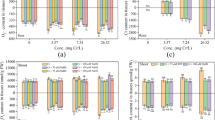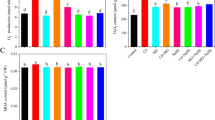Abstract
Cadmium (Cd)-induced growth inhibition is one of the primary factors limiting phytoremediation effect of Boehmeria nivea (L.) Gaud in contaminated soil. Sodium nitroprusside (SNP), a donor of nitric oxide (NO), has been evidenced to alleviate Cd toxicity in many plants. However, as an important mechanism of NO in orchestrating cellular functions, S-nitrosylation is still poorly understood in its relation with Cd tolerance of plants. In this study, higher exogenous NO levels were found to coincide with higher S-nitrosylation level expressed as content of S-nitrosothiols (SNO). The addition of low concentration (100 μM) SNP increased the SNO content, and it simultaneously induced an alleviating effect against Cd toxicity by enhancing the activities of superoxide dismutase (SOD), ascorbate peroxidase (APX), and glutathione reductase (GR) and reduced the accumulation of H2O2 as compared with Cd alone. Application of S-nitrosoglutathione reductase (GSNOR) inhibitors dodecanoic acid (DA) in 100 μM SNP group brought in an extra elevation in S-nitrosylation level and further reinforced the effect of SNP. While the additions of 400 μM SNP and 400 μM SNP + 50 μM DA further elevated the S-nitrosylation level, it markedly weakened the alleviating effect against Cd toxicity as compared with the addition of 100 μM SNP. This phenomenon could be owing to excess consumption of glutathione (GSH) to form SNO under high S-nitrosylation level. Therefore, the present study indicates that S-nitrosylation is involved in the ameliorating effect of SNP against Cd toxicity. This involvement exhibited a concentration-dependent property.





Similar content being viewed by others
Abbreviations
- SNP:
-
Sodium nitroprusside
- ROS:
-
Reactive oxygen species
- SNO:
-
S-Nitrosothiol
- GSNOR:
-
S-Nitrosoglutathione reductase
- GSH:
-
Glutathione
- APX:
-
Ascorbate peroxidase
- GR:
-
Glutathione reductase
- O2 − :
-
Superoxide anion radical
- MDA:
-
Malondialdehyde
References
Alvarez B, Radi R (2003) Peroxynitrite reactivity with amino acids and proteins. Amino Acids 25:295–311
Anderson ME (1984) Determination of glutathione and glutathione disulfide in biological samples. Methods Enzymol 113:548–555
Arasimowicz-Jelonek M, Floryszak-Wieczorek J, Gwóźdź EA (2011) The message of nitric oxide in cadmium challenged plants. Plant Sci 181:612–620
Bai X, Yang L, Tian M, Chen J, Shi J, Yang Y, Hu X (2011) Nitric oxide enhances desiccation tolerance of recalcitrant Antiaris toxicaria seeds via protein S-nitrosylation and carbonylation. PLoS One 6:e20714
Barroso JB, Corpas FJ, Carreras A, Rodríguez-Serrano M, Esteban FJ, Fernández-Ocaña A, Chaki M, Romero-Puertas MC, Valderrama R, Sandalio LM (2006) Localization of S-nitrosoglutathione and expression of S-nitrosoglutathione reductase in pea plants under cadmium stress. J Exp Bot 57:1785–1793
Bradford MM (1976) A rapid and sensitive method for the quantitation of microgram quantities of protein utilizing the principle of protein-dye binding. Anal Biochem 72:248–254
Chaki M, Fernández-Ocaña AM, Valderrama R, Carreras A, Esteban FJ, Luque F, Gómez-Rodríguez MV, Begara-Morales JC, Corpas FJ, Barroso JB (2009) Involvement of reactive nitrogen and oxygen species (RNS and ROS) in sunflower–mildew interaction. Plant Cell Physiol 50:265–279
Chaoui A, Mazhoudi S, Ghorbal MH, El Ferjani E (1997) Cadmium and zinc induction of lipid peroxidation and effects on antioxidant enzyme activities in bean (Phaseolus vulgaris L.). Plant Sci 127:139–147
Corpas FJ, Chaki M, Fernández-Ocaña A, Valderrama R, Palma JM, Carreras A, Begara-Morales JC, Airaki M, del Río LA, Barroso JB (2008) Metabolism of reactive nitrogen species in pea plants under abiotic stress conditions. Plant Cell Physiol 49:1711–1722
Delledonne M, Zeier J, Marocco A, Lamb C (2001) Signal interactions between nitric oxide and reactive oxygen intermediates in the plant hypersensitive disease resistance response. Proc Natl Acad Sci 98:13454–13459
Dong J, Wu F, Zhang G (2006) Influence of cadmium on antioxidant capacity and four microelement concentrations in tomato seedlings (Lycopersicon esculentum). Chemosphere 64:1659–1666
Drążkiewicz M, Skórzyńska-Polit E, Krupa Z (2003) Response of the ascorbate–glutathione cycle to excess copper in Arabidopsis thaliana (L.). Plant Sci 164:195–202
Feechan A, Kwon E, Yun B-W, Wang Y, Pallas JA, Loake GJ (2005) A central role for S-nitrosothiols in plant disease resistance. Proc Natl Acad Sci 102:8054–8059
Foyer C, Halliwell B (1976) The presence of glutathione and glutathione reductase in chloroplasts: a proposed role in ascorbic acid metabolism. Planta 133:21–25
Foyer CH, Noctor G (2005) Oxidant and antioxidant signalling in plants: a re-evaluation of the concept of oxidative stress in a physiological context. Plant Cell Environ 28:1056–1071
Gratão P, Monteiro C, Antunes A, Peres L, Azevedo R (2008) Acquired tolerance of tomato (Lycopersicon esculentum cv. Micro-Tom) plants to cadmium‐induced stress. Ann Appl Biol 153:321–333
Grennan AK (2007) Protein S-nitrosylation: potential targets and roles in signal transduction. Plant Physiol 144:1237–1239
Innocenti G, Pucciariello C, Le Gleuher M, Hopkins J, Stefano M, Delledonne M, Puppo A, Baudouin E, Frendo P (2007) Glutathione synthesis is regulated by nitric oxide in Medicago truncatula roots. Planta 225:1597–1602
Jensen D, Belka G, Du Bois G (1998) S-Nitrosoglutathione is a substrate for rat alcohol dehydrogenase class III isoenzyme. Biochem J 331:659–668
Jiménez A, Gómez JM, Navarro E, Sevilla F (2002) Changes in the antioxidative systems in mitochondria during ripening of pepper fruits. Plant Physiol Biochem 40:515–520
Kubienová L, Tichá T, Jahnová J, Luhová L, Mieslerová B, Petřivalský M (2014) Effect of abiotic stress stimuli on S-nitrosoglutathione reductase in plants. Planta 239:139–146
Kuźniak E, Skłodowska M (2001) Ascorbate, glutathione and related enzymes in chloroplasts of tomato leaves infected by Botrytis cinerea. Plant Sci 160:723–731
Laspina NV, Groppa MD, Tomaro ML, Benavides MP (2005) Nitric oxide protects sunflower leaves against Cd-induced oxidative stress. Plant Sci 169:323–330
Liu L, Hausladen A, Zeng M, Que L, Heitman J, Stamler JS (2001) A metabolic enzyme for S-nitrosothiol conserved from bacteria to humans. Nature 410:490–494
Luna CM, González CA, Trippi VS (1994) Oxidative damage caused by an excess of copper in oat leaves. Plant Cell Physiol 35:11–15
Nakano Y, Asada K (1987) Purification of ascorbate peroxidase in spinach chloroplasts; its inactivation in ascorbate-depleted medium and reactivation by monodehydroascorbate radical. Plant Cell Physiol 28:131–140
Nieboer E, Richardson DHS (1980) The replacement of the nondescript term ‘heavy metals’ by a biologically and chemically significant classification of metal ions. Environmental Pollution Series B, Chemical and Physical 1:3–26
Noctor G, Foyer CH (1998) ASCORBATE AND GLUTATHIONE: keeping active oxygen under control. Annu Rev Plant Physiol Plant Mol Biol 49:249–279
Noctor G, Arisi A-CM, Jouanin L, Kunert KJ, Rennenberg H, Foyer CH (1998) Glutathione: biosynthesis, metabolism and relationship to stress tolerance explored in transformed plants. J Exp Bot 49:623–647
Ortega-Galisteo AP, Rodríguez-Serrano M, Pazmiño DM, Gupta DK, Sandalio LM, Romero-Puertas MC (2012) S-Nitrosylated proteins in pea (Pisum sativum L.) leaf peroxisomes: changes under abiotic stress. J Exp Bot 63:2089–2103
Panda P, Nath S, Chanu TT, Sharma GD, Panda SK (2011) Cadmium stress-induced oxidative stress and role of nitric oxide in rice (Oryza sativa L.). Acta Physiol Plant 33:1737–1747
Patterson BD, MacRae EA, Ferguson IB (1984) Estimation of hydrogen peroxide in plant extracts using titanium(IV). Anal Biochem 139:487–492
Qadir S, Qureshi MI, Javed S, Abdin MZ (2004) Genotypic variation in phytoremediation potential of Brassica juncea cultivars exposed to Cd stress. Plant Sci 167:1171–1181
Sandalio LM, Dalurzo HC, Gomez M, Romero‐Puertas MC, Del Rio LA (2001) Cadmium‐induced changes in the growth and oxidative metabolism of pea plants. J Exp Bot 52:2115–2126
Sanghani PC, Davis WI, Fears SL, Green S-L, Zhai L, Tang Y, Martin E, Bryan NS, Sanghani SP (2009) Kinetic and cellular characterization of novel inhibitors of S-nitrosoglutathione reductase. J Biol Chem 284:24354–24362
Sanità di Toppi L, Gabbrielli R (1999) Response to cadmium in higher plants. Environ Exp Bot 41:105–130
Singh HP, Batish DR, Kaur G, Arora K, Kohli RK (2008) Nitric oxide (as sodium nitroprusside) supplementation ameliorates Cd toxicity in hydroponically grown wheat roots. Environ Exp Bot 63:158–167
Smeets K, Cuypers A, Lambrechts A, Semane B, Hoet P, Van Laere A, Vangronsveld J (2005) Induction of oxidative stress and antioxidative mechanisms in Phaseolus vulgaris after Cd application. Plant Physiol Biochem 43:437–444
Sohal RS, Mockett RJ, Orr WC (2002) Mechanisms of aging: an appraisal of the oxidative stress hypothesis. Free Radic Biol Med 33:575–586
Squadrito GL, Pryor WA (1995) The formation of peroxynitrite in vivo from nitric oxide and superoxide. Chem Biol Interact 96:203–206
Srivastava S, Tripathi RD, Dwivedi UN (2004) Synthesis of phytochelatins and modulation of antioxidants in response to cadmium stress in Cuscuta reflexa—an angiospermic parasite. J Plant Physiol 161:665–674
Stewart RRC, Bewley JD (1980) Lipid peroxidation associated with accelerated aging of soybean axes. Plant Physiol 65:245–248
Vig K, Megharaj M, Sethunathan N, Naidu R (2003) Bioavailability and toxicity of cadmium to microorganisms and their activities in soil: a review. Adv Environ Res 8:121–135
Wang X, Liu Y, Zeng G, Chai L, Song X, Min Z, Xiao X (2008) Subcellular distribution and chemical forms of cadmium in Bechmeria nivea (L.) Gaud. Environ Exp Bot 62:389–395
Wang Q, Liang X, Dong Y, Xu L, Zhang X, Hou J, Fan Z (2012) Effects of exogenous nitric oxide on cadmium toxicity, element contents and antioxidative system in perennial ryegrass. Plant Growth Regul 69:11–20
Xiong J, Fu G, Tao L, Zhu C (2010) Roles of nitric oxide in alleviating heavy metal toxicity in plants. Arch Biochem Biophys 497:13–20
Xu J, Wang W, Yin H, Liu X, Sun H, Mi Q (2010) Exogenous nitric oxide improves antioxidative capacity and reduces auxin degradation in roots of Medicago truncatula seedlings under cadmium stress. Plant Soil 326:321–330
Zheng W, Liu Y, Pan S, Yuan W, Dai Y, Wei J (2011) Involvements of S-nitrosylation and denitrosylation in the production of polyphenols by Inonotus obliquus. Appl Microbiol Biotechnol 90:1763–1772
Acknowledgments
The authors would like to thank the financial support from the National Natural Science Foundation of China (Grant No. 41271332), the Natural Science Foundation of Hunan Province, China (Grant No. 11JJ2031), and the Science and Technology Planning Project of Hunan Province, China (Grant No. 2012SK2021).
Author information
Authors and Affiliations
Corresponding author
Additional information
Responsible editor: Philippe Garrigues
Rights and permissions
About this article
Cite this article
Wang, D., Liu, Y., Tan, X. et al. Effect of exogenous nitric oxide on antioxidative system and S-nitrosylation in leaves of Boehmeria nivea (L.) Gaud under cadmium stress. Environ Sci Pollut Res 22, 3489–3497 (2015). https://doi.org/10.1007/s11356-014-3581-5
Received:
Accepted:
Published:
Issue Date:
DOI: https://doi.org/10.1007/s11356-014-3581-5




